Ecological airdrop season is coming, can DFINITY return to its peak?
Will DFINITY return to its peak during the upcoming ecological airdrop season?Author: Baize Research Institute
Do you remember the former king-level project DFINITY?
In May 2018, 50,000 registered participants received ICP token airdrops.
In August 2018, DFINITY raised $102 million from a16z, Polychain Capital, KR1, Amino Capital, and other crypto venture capitalists, forming an all-star team with over 215 members, most of whom are world-class cryptography technology, academic and leadership talents.
- In-depth Explanation of ZeroSync Starkware’s Zero Knowledge Proof System Developed for Bitcoin
- In-depth Analysis of ZeroSync Starkware’s Zero-Knowledge Proof System Developed for Bitcoin
- Interpretation and Comparison of the EU’s Cryptocurrency Market Regulation Act (MiCA)
In May 2021, the highly anticipated Internet Computer (IC), developed and maintained by the DFINITY Foundation, officially launched its mainnet.
DFINITY attracted investors, application developers, and communities in the early stages of development, thanks to founder Dominic Williams’ visionary concept of DFINITY: a decentralized “world computer,” a public chain that can build fully on-chain DApps without using centralized cloud services like AWS, a public chain that can support countless high-performance DApps, and a infinitely scalable decentralized cloud computing platform.
Vitalik Buterin, the co-founder of Ethereum, has mentioned DFINITY on several important occasions. During the recent EDCON 2023 conference, Vitalik referred to the IC network developed by DFINITY as Ethereum’s sister network, rather than a competitor.
However, all of this has disappeared with the fall of the ICP token price, community criticism of the network system, the development of multi-chain narratives, and the recent Ethereum L2 frenzy. In just a few months, it went from being a “king” to “fallen.” From the initial explosion of popularity and heated discussions, there is now little mention of DFINITY and ICP in the Chinese crypto community. Along with other star projects at the same time (such as Chia, Filcoin, etc.), it has become a representative project that reached its peak as soon as it debuted. (Recommended reading: “The Inevitable Ending of Non-EVM Public Chains? A Multi-perspective Analysis of the Reasons for ICP’s Decline”)
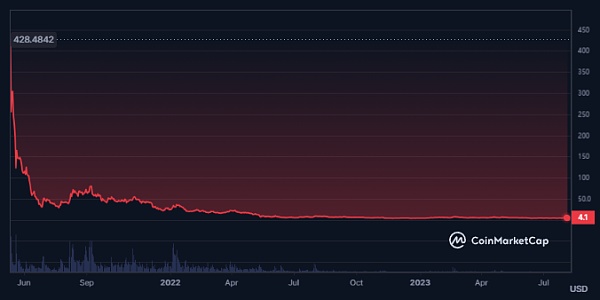
Now, two years after the IC mainnet went live, how has the technology development and ecosystem performance been? In this article, the author will introduce the development process of the IC network over the past two years from three aspects: ICP 1.0, ICP 2.0, and the ecosystem airdrop season. (Note: 1.0 and 2.0 are unofficial definitions)
ICP 1.0: Perfecting the underlying infrastructure and expanding the network through on-chain governance
NNS: The on-chain governance system built into IC
Since the launch of the IC network’s mainnet in May 2021, it has undergone more than 140 upgrades, which is an incredible number.
All of this is thanks to the on-chain governance system designed for the ICP token, the Network Nervous System (NNS).
Every ICP holder can become a neuron by locking their ICP and participate in the NNS, and they will receive system rewards for participating in governance. This is similar to the “staking mining” model, where participants lock their own ICP tokens to obtain voting weights and corresponding rewards based on the amount and duration of their stakes. The longest stake duration is 8 years, which is the origin of the largest community in the ICP ecosystem, called the 8-year gang, composed of a group of loyal supporters of ICP, accompanying the growth of the IC network.
The proposals of NNS cover almost every aspect of the IC network, including modifying system parameters and rules, system optimization and upgrade, freezing and unfreezing accounts, adding or reducing subnets, and approving nodes, etc. Once a proposal is approved, the IC network will automatically upgrade based on the parameters in the proposal.
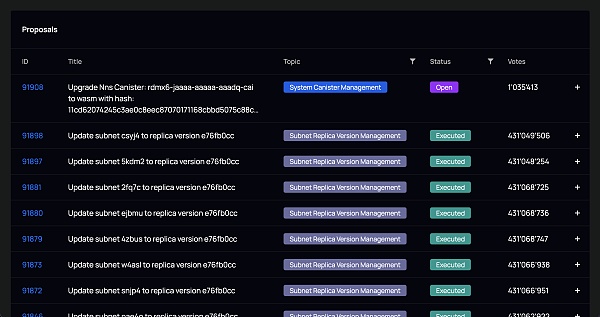
In other words, NNS represents the voice of the ICP community, and the IC network upgrades accordingly based on the community’s voice.
However, due to the fact that any neuron can initiate a proposal, NNS does have a large number of spam proposals, and neurons that support spam proposals can earn more token rewards by actively participating in governance voting. Although the development team has made multiple suggestions for modifications, this issue has not been effectively resolved to date.
Currently, NNS has staked approximately $1.4 billion worth of ICP, enough to make the IC network one of the highest TVL public chain ecosystems.
Infinite Subnets: Supporting the narrative of the “world computer” of the IC network
At the time of writing this article, the TPS of the IC network is about 5,200 transactions per second, which is another astonishing number. But its upper limit is infinite.

Ethereum is focusing on the transition to sharding, but the IC network already had its own sharding solution since its launch, namely subnets. Subnets are a special type of blockchain in the IC network that can seamlessly integrate with other subnets, expanding the capacity of the entire IC network by adding subnets.
If the IC network needs more computing power and storage resources, through community regulation by NNS proposals, the system will combine nodes to create new subnets. Subnets interact with each other through ChainKey technology, so smart contracts within the same subnet or different subnets can communicate directly.
Currently, the IC network has 40 subnets, and this number will continue to increase in the future as the IC network is further adopted and developed to meet growing capacity demands.
Despite its powerful technical architecture and the strong technical foundation it has provided for DApps, unfortunately, due to the manipulation of the ICP price by SBF, the founder of FTX, many investors and developers have lost confidence in the IC network, causing a double blow to the token price and ecosystem. The year 2022 brought bankruptcy, collapse, and bear market panic. Fortunately, the early applications of the IC ecosystem silently persevered, and the community survived this year amidst the arguments of bullishness and bearishness.
ICP 2.0: Technological Expansion, Ecological Takeoff
Looking at the entire Web3 ecosystem, it is rare to see a public chain like DFINITY that “enjoys itself in its own world and goes with the flow in other people’s worlds.”
In the Web3 industry, there are plenty of projects that run away with the money, let alone in a bear market where funds are scarce, profits are shrinking, and the community is in turmoil. To determine whether a team has a tendency to run away, it also depends on whether they are doing serious work in the face of community mockery and attacks, continuously developing products, or gradually disappearing and lying flat. Some projects, in order to survive, are willing to abandon their original vision and chase after hotspots.
On Twitter, community members often suggest to founder Dom to take a different path, such as whether to vigorously promote IC NFT in line with the NFT craze? Only by continuously introducing new users to the IC ecosystem can the token price and the struggling ecosystem be revitalized.
Clearly, DFINITY still needs to stick to its own path, a path that must be taken for twenty years. In the article “Announcing the “Mainnet” and 20-Year Roadmap for Internet Computers,” Dom reveals the long-term development path of DFINITY. This path is not about “Killing ETH” or becoming No.1 in the crypto and blockchain industry, but…
5 years later (2026): More and more Web2 traditional entrepreneurs and development teams are developing products on the IC network, making it easier to raise funds for DAO governance.
10 years later (2031): Become the “open internet” of the technology industry, the true Web3.
20 years later (2041): Become a bigger “open internet” than Web2, extending into everyone’s life.
Two years after the launch of the mainnet, DFINITY is still actively exploring multiple key technological areas, working hard to achieve this roadmap.
ckTokens: Moving towards a multi-chain ecosystem
In August 2022, the DFINITY Foundation announced that it had successfully integrated the IC network with the Bitcoin network. Simply put, each subnet and smart contract in the IC network can use threshold ECDSA signatures to receive, store, and send real bitcoins on the Bitcoin blockchain. (Not a cross-chain bridge, all transactions using this method will be broadcast on the Bitcoin blockchain.)
To facilitate the circulation and application of Bitcoin in the IC network, based on this technology, the development team has launched ckBTC, a Bitcoin-anchored token similar to WBTC, managed by the ckBTC smart contract (issuance, destruction). Users can mint ckBTC by sending real BTC to this smart contract, and conversely, when users send ckBTC to the smart contract, the smart contract will pay BTC to the user’s Bitcoin wallet.
In other words, transactions will only be settled on the Bitcoin network when users transfer BTC into the IC network and transfer ckBTC out. Therefore, users using ckBTC in the IC network will not be troubled by the slow transaction speed and high transaction fees of the Bitcoin network.
In fact, there are already quite a few Bitcoin-anchored tokens in the entire Web3 ecosystem, but ckBTC’s advantages enable it to stand out:
– ckBTC has sufficient collateral, and users can even check the amount of collateral at any time during the transaction.
– ckBTC is completely decentralized and managed directly by the governance system NNS.
– KYT (Know Your Transaction) is enabled to block black bitcoins, making it more secure and compliant.
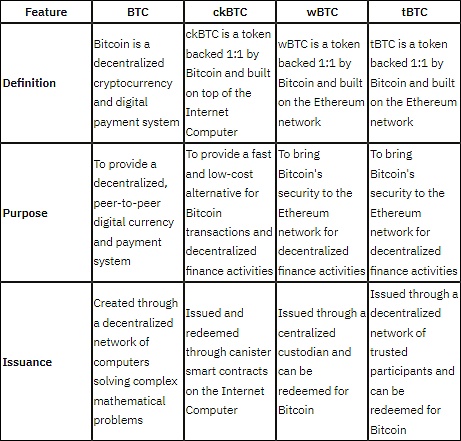
Currently, the total amount of ckBTC on the IC network has reached 47, worth about $1.2 million.
Inspired by ckBTC, DFINITY plans to build a “ckTokens” ecosystem in the future, integrating with more public chains through non-cross-chain bridge integration. It is expected that the IC network will become the “hub” of the future multi-chain ecosystem. Among them, the direct integration with Ethereum and the development of ckETH on the IC network have been put on the agenda.
SNS: DAO LaunchLianGuaid of the ecological project
SNS, which is referred to as the “flagship product” of the IC network along with NNS, was officially launched this year.
NNS and SNS are both core governance infrastructures of the IC network. The former is responsible for the governance system of the entire IC network, while the latter is a “one-stop” governance system specifically designed for ecological DApps to promote their development in open governance, tokenization, transparency, and other aspects.
Every DApp in the IC network can use SNS for rapid token issuance and open governance, which generally requires 5 steps:
– Set SNS parameters
– Transfer control of the DApp
– Submit a proposal to NNS (whether to activate SNS and how much ICP needs to be raised)
– Approved by NNS, start decentralized token sale.
– If the sale meets the target, the DAO is successfully launched and future upgrade proposals for the DApp will be published in the SNS of the project DAO; if the sale fails to meet the target, control will be returned to the project party.
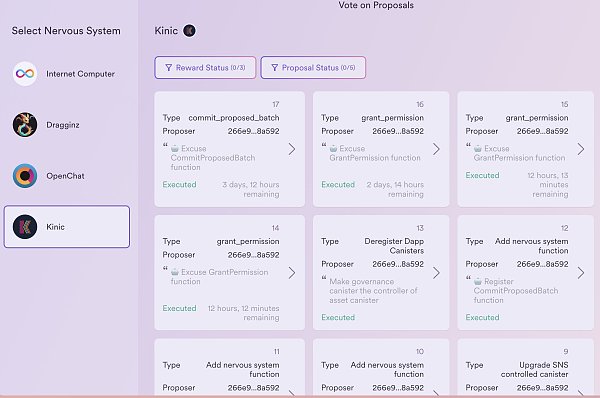
Users can participate in the decentralized token sale of DApps through the “LaunchLianGuaid” function on NNS and pay directly with ICP.
Currently, 5 projects have successfully become DAOs through SNS, namely the decentralized chat application OpenChat, the decentralized short video platform Hot or Not, the decentralized search engine Kinic, the first meme coin on the IC network ICGhost, and the Web3 game Dragginz. There are 3 platforms currently in the proposal stage, namely the decentralized community management platform Catalyze, the decentralized gaming platform Boom DAO, and the AI computing power trading platform EMC.
Airdrop Season is Coming: Can the IC Ecosystem Explode?
If you have been following the ecosystem since the launch of the IC mainnet, due to the lack of unified token standards, the development of DeFi has been relatively slow. The most noticeable observation is that most early-stage ecological projects are mainly SocialFi, with many of them benchmarking Web2 platform giants.
In fact, the design of the IC network naturally suits DApps that require high performance, such as SocialFi and games. On most mainstream public chains, all operations involving on-chain interactions (contract function calls) require payment of a certain amount of gas fees, and the cost of interactions is influenced by the price of native tokens in the secondary market. Additionally, in the case of network congestion, the cost of interactions will also increase accordingly.
The IC network implements a “Reverse Gas” model, which, as the name suggests, is opposite to the traditional blockchain Gas model mechanism. As users, we do not need to pay any Gas fees when interacting with the chain. Instead, the developer pre-pays the interaction Gas in the smart contract, similar to the mechanism of the traditional Internet, where the developer bears the cost of application platform operation, maintenance, and hosting.
This greatly improves usability. Compared to Ethereum, where users have to buy ETH from exchanges and withdraw it to their wallets in order to use DeFi and NFT applications on ETH, this threshold directly blocks most potential users. On the IC network, developers provide Gas for running DApps in smart contracts, and users just need to enjoy the services. In this way, users can easily use DApps without even knowing that the application is running on a blockchain.
Currently, most of the early applications in the IC ecosystem have been officially launched, and some have started preparing for SNS token sales, so there are many airdrop expectations. Moreover, with the attraction of being able to launch DAO with a single click on SNS, more and more projects are starting to be built on the IC network.
(Due to space limitations, only some of the popular DApps on the IC network are listed below. For more DApps, please refer to the list I created: http://reurl.cc/QXkNK9)
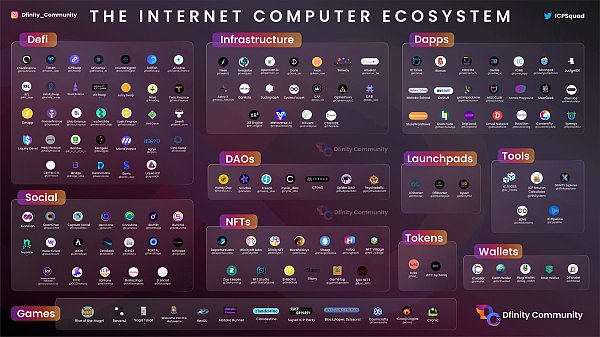
1. DeFi
Infinity Swap
A well-known IC DeFi platform.
Notable investors include PolyChain and a16z. They have clear plans for interactive airdrops and SNS token issuance.
Bitfinity
Introduced by Infinity Swap, it is an Ethereum L2 (IC EVM layer) aiming to connect IC with Ethereum.
Currently in the testnet stage, official products include wallets, cross-chain bridges, and block explorers. It is attracting more projects to build on it. When the mainnet is officially launched, it may trigger a wave in the IC community, and the issuance of SNS tokens is worth paying attention to.
ICDex
An early DEX on the IC network with relatively good liquidity and support for multiple currencies.
Active on Twitter with a large following. The official products also include IC Swap. It is currently transitioning to multi-chain asset DeFi (token cross-chain). On ICDex, you can engage in trading mining to earn ICL token rewards, which can be traded on ICP Swap.
ICP Swap
An established DeFi platform on the IC network, offering features such as token exchange, liquidity mining, NFT marketplace, and governance. It plans to launch chat functionality in the near future.
The token is clearly identified as ICS, with a total supply of 1 billion. It is expected to be issued on SNS in the second half of this year and become a DAO. There are expected to be interactive airdrops.
Sonic
A new force in the IC ecosystem of DeFi, offering features such as token exchange, liquidity mining, and LBP (issuing tokens through liquidity bootstrapping pools).
According to the co-founder, the liquidity mining function will be launched soon, and all liquidity pool creators will receive token airdrops.
Funded
IC version of Gitcoin. Projects and communities can raise funds on this platform and provide NFTs with custom reward benefits to donors, such as token airdrops and discounts during token sales. NFTs can be traded on this platform. So far, many popular projects on IC have launched crowdfunding campaigns on this platform, including HOT or NOT and Catalyze.
Users can receive rewards by donating to promising new projects. For example, Catalyze, which recently conducted decentralized token sales on SNS, will airdrop tokens to NFT holders who donate on Funded.
2. SocialFi
Openchat
One of the earliest social applications on IC, the IC version of Telegram. It supports creating group chats, sending emojis, sending red envelopes (ICP, ckBTC), and will introduce voice and video chat functions in the future. Each regular user has 0.1GB of free storage space for messages, while diamond members have unlimited space.
The token OC has been issued through SNS. Currently, by upgrading to a diamond member of Openchat, you can obtain an invitation link and invite friends to register and receive CHAT token rewards. In addition, later this year, Openchat will launch a reputation system (through DAO proposals), allowing users to earn money while chatting, but it will focus on reviewing robot spam messages.
DSCVR
One of the earliest social applications on IC, the IC version of Reddit. It supports posting, liking, commenting, rewarding, creating and joining topic portals, and the latest version also launched a web gaming platform where developers can submit and upload their own games. Polychain led a $9 million investment in DSCVR.
As an early IC project, it has not yet issued tokens on SNS. However, if the project issues tokens in the future, there is a high probability of airdrops, as the platform has previously conducted large-scale airdrops of SNS-1 tokens. Therefore, interested users can interact more without much cost. In addition, DSCVR often holds joint events with other projects, offering prizes for participation.
Distrikt
One of the earliest social applications on IC, the IC version of Twitter. It supports posting, liking, commenting, and using hashtags.
According to the roadmap, the project will issue tokens on SNS in the fourth quarter of this year. There may be airdrops, so users can interact more.
Hot or Not
The IC version of Douyin (TikTok). It brings the short video Douyin mode to IC and uses the unique token economy of Web3 to stimulate the enthusiasm of passive users.
Recently, the project completed its token issuance plan on SNS. Currently, it is conducting an airdrop distribution campaign. By registering for the project before July 15, 2023, participants can receive HOT+COYN airdrops. In addition, as a Web3 project, Hot or Not is committed to earning money through video swiping. Therefore, interested users can interact more, and in the future, there may be token airdrops based on rankings or behavioral activities.
Catalyze
Catalyze is a community governance platform where creators can join, create their own groups, and interact with their fans. They can also create NFTs to unlock online or offline activities.
At the time of writing this article, Catalyze is conducting a decentralized token sale on SNS. In addition, the official roadmap indicates that there is an airdrop plan, so early participants/official NFT holders should pay attention to when the airdrop will happen.
Seers
Seers is an IC version of Twitter that is more similar to Distrikt, but has fewer active users.
Currently, Seers only has the activity of earning tokens by posting, and rewards ICP tokens based on the users’ posting activity every week, but the rewards are minimal. Moreover, to prevent bots, users must stake 1 ICP when registering, which hinders user adoption. However, one good thing is that Seers also plans to issue tokens on SNS and become a DAO.
Dmail
Dmail is the first decentralized email service on Web3, with features including communication, domain names, asset transfers, NFT avatars, subscriptions, and notifications. Notable investors include Hashkey, Kucoin, and BiXin. In addition to the IC network, Dmail has now integrated with other networks, including Starknet, Sei, ETH, Solana, etc.
Recently, Dmail first collaborated with Worldcoin, then completed a Pre-A round of financing, and actively cooperated with other wallet projects to accelerate adoption. It currently has 550,000 registered domain name accounts and over 300,000 individual addresses, showing great potential. Currently, Dmail adopts a points system and is expected to have airdrops in the future.
3. Games/NFTs/Metaverse
Plethora
IC version of “Egg Party”. Completing daily tasks gives players a chance to win NFTs from the game’s official partners.
IC1101
One of the early projects in the IC ecosystem, a metaverse platform built on the IC network.
Currently in the testnet phase, with outstanding graphics quality and strong technical capabilities, it has been selected for the Future3 incubator program supported by Hashkey. However, the development team’s marketing efforts have been somewhat unsatisfactory.
BoomDAO
BoomDAO’s flagship product is a decentralized game launcher that integrates many game projects built on the IC network. Users can link their wallets with one click and play different games. Game developers can quickly upload games, issue tokens or NFTs. In addition, BoomDAO is also committed to developing game developer-friendly tools such as a universal game engine.
They plan to issue tokens through SNS in August and have confirmed an airdrop. You can quickly join the community on the official website and participate in the airdrop.
Yumi
The most popular NFT trading market on the IC network, at the forefront of the IC NFT field.
Conclusion
The author highly agrees with Herbert, the Asia-Pacific General Manager of DFINITY, as stated in the interview “ICP: Responding to Doubts, Entering Hong Kong, and Setting Sail for the IC Ecosystem,” “The narrative of financial investment has become tired, and the market will eventually return to the essence and focus on the underlying infrastructure services of the Internet. DFINITY has chosen the most difficult and even lonely path because we believe it is the only path that can be sustained and worth pursuing. Once this muddy path is taken, it will become wider and smoother.”
DFINITY has indeed done many great things, such as the very original token economics, reverse Gas model, NNS on-chain democratic governance, and so on.
However, DFINITY has also made bad choices, such as establishing a long-term stable governance system by incentivizing neuron lock-up for 8 years, but it has caused permanent “oligopoly politics”.
However, it is commendable that from ICP 1.0 to 2.0, DFINITY has always adhered to the original vision, a public chain that can build fully on-chain DApps without the need for centralized cloud services such as AWS, a public chain that can support countless high-performance DApps. In the continuous development of the development team, it is believed that DFINITY will get closer and closer to its 20-year roadmap.
Early ecological projects have also gradually grown into strong “Web2 killers” through silent cultivation. With the arrival of the ecological airdrop season, can DFINITY, or the IC network, return to its peak? We wait and see.
Risk Warning:
The above projects and opinions should not be construed as investment advice, DYOR. According to the “Notice on Further Preventing and Dealing with the Risks of Virtual Currency Trading Speculation” issued by the central bank and other departments, the content of this article is only for information sharing and does not promote or endorse any business or investment activities. Readers are strictly required to comply with local laws and regulations and not to participate in any illegal financial activities.
We will continue to update Blocking; if you have any questions or suggestions, please contact us!
Was this article helpful?
93 out of 132 found this helpful
Related articles
- Halving Narrative and Reflexivity LTC falls instead of rises, can BTC halving still bring a bull market?
- Hashed Partner The next bull market will be mainly driven by the Asian market, and bottom-up innovation may emerge in Asia.
- Fortune Magazine From ambitious to defensive, what twists and turns has the crypto queen Katie Haun experienced?
- From hard forks to the Lightning Network, who is supporting the Bitcoin ecosystem?
- Semafor The US Department of Justice is considering fraud charges against Binance, but is concerned about a FTX-style run in the market.
- MicroStrategy plans to sell stocks to raise $750 million to purchase Bitcoin.
- Wu said July mining news Smagma big order and Samsung’s new technology, mainland promotes Fil mining machine, Little Deer Bhutan mining fund, etc.




